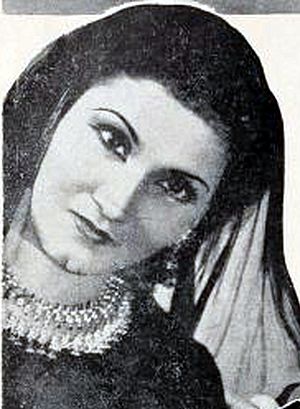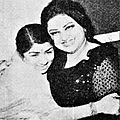Noor Jehan facts for kids
Quick facts for kids
Malika-e-Tarannum
Noor Jehan
PP TI SI
|
|
|---|---|
| نور جہاں | |

Noor Jehan in 1945 film Zeenat
|
|
| Born |
Allah Rakhi Wasai
23 September 1926 Kasur, Punjab, British India
|
| Died | 23 December 2000 (aged 74) |
| Resting place | Gizri Graveyard, Karachi |
| Nationality | British Indian (1926–1947) Pakistani (1947–2000) |
| Other names | The Nightingale of The East Queen of Hearts Daughter of Nation The Nightingale of Punjab |
| Occupation |
|
| Years active | 1930 - 2000 |
|
Notable work
|
|
| Style |
|
| Title | "Malika-e-Tarannum" (Queen of Melody) |
| Spouse(s) |
Shaukat Hussain Rizvi
(m. 1942; div. 1953)Ejaz Durrani
(m. 1959; div. 1971) |
| Children | 4, including Zil-e-Huma, Nazia Ejaz Khan |
| Parent(s) |
|
| Relatives |
|
| Awards | 15 Nigar Awards |
| Honours |
|
Noor Jehan (born Allah Rakhi Wasai; September 23, 1926 – December 23, 2000) was a famous singer and actress. She was known as Malika-e-Tarannum, which means "Queen of Melody."
Noor Jehan worked in movies and music for over 60 years. She started her career in British India and later moved to Pakistan. Many people think she was one of the greatest singers in the Indian subcontinent.
She sang about 20,000 songs in many languages, like Urdu, Hindi, Punjabi, and Sindhi. She holds the record for singing the most film songs in Pakistani cinema. Noor Jehan was also the first female film director in Pakistan.
Contents
Early Life and Beginnings
Noor Jehan was born as Allah Rakhi Wasai in Kasur, British India. She was one of eleven children in her family.
She started singing when she was just six years old. She loved different types of music, including folk songs and theatre music. Her father saw her talent and sent her to learn classical singing. She trained under Ustad Ghulam Mohammad from the age of 11.
Noor Jehan learned traditional Indian classical music styles. These included thumri, dhrupad, and khyal.
Starting Her Career in British India
When she was nine, a musician named Ghulam Ahmed Chishti noticed her. He helped her perform on stage in Lahore. She sang folk songs and poems, but she really wanted to act and sing for movies.
After her training, Noor Jehan and her older sisters sang and danced in Lahore. They often performed before movies were shown in cinemas. A theatre owner took her to Calcutta in the early 1930s. Her family moved there to help her and her sisters start movie careers.
It was in Calcutta that she got her stage name, Baby Noor Jehan. Her sisters were called the "Punjab Mail."
In 1935, Noor Jehan acted in her first Punjabi movie, Pind di Kuri. She sang a popular song in it called "Langh aja patan chanaan da o yaar." She also acted in other films as a child.
In 1942, she got her first main role as an adult in the film Khandaan. This movie was a big success. After this, she moved to Bombay with the film's director, Syed Shaukat Hussain Rizvi. She married him later that year.
From 1945 to 1947, Noor Jehan was one of the biggest actresses in the Indian film industry. Her movies like Zeenat, Anmol Ghadi, and Jugnu were very popular. Mirza Sahiban was her last film released in India.
Moving to Pakistan and Acting Career
In 1947, Noor Jehan and her husband, Shaukat Rizvi, moved to Pakistan. They settled in Karachi.
Three years later, she starred in her first Pakistani film, Chan Wey (1951). She was the main actress and also sang in it. She and Shaukat Rizvi directed this film together. This made Noor Jehan Pakistan's first female film director. Chan Wey was a huge hit in Pakistan. Her next film, Dupatta (1952), was even more successful.
In 1953, she and Rizvi divorced. She kept her three children. In 1959, she married another actor, Ejaz Durrani. He encouraged her to stop acting in films.
Her last film as an actress and singer was Ghalib (1961). She stopped acting in films completely in 1963. She had been acting for 33 years. Being a mother of six children and a wife made her decide to focus on her family. She made 14 films in Pakistan as an actress.
Becoming a Playback Singing Star
After she stopped acting, Noor Jehan focused only on playback singing. This means singing for actors in movies. She started doing this full-time in 1960.
She received many awards for her singing. In 1965, the Pakistani Government gave her the Pride of Performance award. She sang many duets (songs with two singers) with other famous singers.
Noor Jehan was friends with many singers across Asia. She loved to attend live music concerts of other great artists. The famous Indian singer Lata Mangeshkar said that Noor Jehan's voice was amazing. She could sing very low or very high, and her voice always sounded perfect.
During the 1965 war between Pakistan and India, Noor Jehan sang many patriotic songs. These songs made her even more popular.
In 1982, she visited India. She met the Indian Prime Minister, Indira Gandhi. She also met many old friends and co-stars from her time in India.
In 1991, she was invited to perform at the Royal Albert Hall in London. This was a special event to help children in the Middle East. Many other famous singers and actors were there.
Personal Life
Noor Jehan married Shaukat Hussain Rizvi in 1942. They moved to Pakistan in 1947. Their marriage ended in divorce in 1953. They had three children together, including their daughter Zil-e-Huma, who also became a singer.
In 1959, Noor Jehan married Ejaz Durrani. This marriage also ended in divorce in 1971. She had three more children with him.
Later Years and Passing Away
In her later years, Noor Jehan faced some health problems. She had heart surgery in 1986. She also had kidney disease and needed dialysis.
On December 23, 2000, Noor Jehan passed away from heart failure in Karachi. Her funeral was attended by many people. She was buried in the Gizri Graveyard in Karachi.
After her death, the President of Pakistan, Pervez Musharraf, said she deserved a state funeral. A famous Indian writer, Javed Akhtar, said that Noor Jehan was a "common bridge" between Pakistan and India because of her cultural impact.
Awards and Honours
Noor Jehan received over 15 Nigar Awards for her singing. She also won the Millennium Singer Award in Pakistan.
- In 1945, she won a gold medal for her film Zeenat.
- She was ranked among the most influential Pakistanis.
- The British newspaper Eastern Eye ranked her 16th among the top 20 Bollywood singers ever.
- In 1945, she became the first woman in the subcontinent to sing Qawwali in the film Zeenat.
- The American singer Madonna once said, "I can copy every singer but not Noor Jehan."
- In 1965, she received the Pride of Performance award from the President of Pakistan.
- She was also given the Tamgha-e-Imtiaz by the army for her patriotic songs during the 1965 war.
- In 1996, she received the Sitara-e-Imtiaz.
- In January 2000, Pakistan Television (PTV) called her the "Voice of Century."
- In August 2014, she was named the Greatest Female Singer of Pakistan of all time.
- She was also known as the Cultural Ambassador of Pakistan.
- On September 21, 2017, Google Doodle celebrated her 91st birthday.
Filmography
Films
| Year | Film | Notes |
|---|---|---|
| 1935 | Pind Di Kudi | as Child artist |
| 1935 | Sheela | |
| 1936 | Misr Ka Sitara | as Child artist |
| 1937 | Heer-Sayyal | as Child artist |
| 1939 | Gul Bakawli | |
| 1939 | Imandaar | |
| 1939 | Pyam-e-Haq | |
| 1936 | Gul-e-Bakawali | as Child artist |
| 1940 | Sajani | |
| 1940 | Yamla Jat | |
| 1941 | Chaudhry | |
| 1941 | Red Signal | |
| 1941 | Umeed | |
| 1941 | Susral | |
| 1942 | Chandani | |
| 1942 | Dheeraj | |
| 1942 | Faryad | |
| 1942 | Khandan | Shot in Lahore. Second Highest Grossing Indian Film of 1942 |
| 1943 | Naadaan | |
| 1943 | Duhai | |
| 1943 | Naukar | Fifth Highest Grossing Indian Film of 1943 |
| 1944 | Lal Haveli | |
| 1944 | Dost | |
| 1945 | Zeenat | Highest Grossing Indian Film of 1945 |
| 1945 | Gaon Ki Gori | Second Highest Indian Grossing Film of 1945 |
| 1945 | Badi Maa | Third Highest Grossing Indian Film of 1945 |
| 1945 | Bhai Jaan | |
| 1946 | Anmol Ghadi | Highest Grossing Indian Film of 1946 (with Surendra (actor)) |
| 1946 | Dil | |
| 1946 | Humjoli | |
| 1946 | Sofia | |
| 1946 | Maharana Pratap | |
| 1947 | Mirza Sahibaan | Fourth Highest Grossing Indian Film of 1947 |
| 1947 | Jugnu | Highest Grossing Indian Film of 1947 (with Dilip Kumar) |
| 1947 | Abida | |
| 1947 | Mirabai | |
| 1951 | Chan Wey | First Film in Pakistan, Biggest Hit of 1951 |
| 1952 | Dopatta | Biggest Hit of 1952 in Pakistan |
| 1953 | Gulnar | |
| 1955 | Patey Khan | |
| 1956 | Lakt-e-Jigar | (released 17 February 1956) |
| 1956 | Intezaar | (released 12 May 1956) |
| 1957 | Nooran | (released 30 May 1957) |
| 1958 | Choo mantar | |
| 1958 | Anarkali | (released 6 June 1958) |
| 1959 | Neend | (released 16 October 1959) |
| 1959 | Pardaisan | |
| 1959 | Koel | (released 24 December 1959) |
| 1961 | Ghalib | (released 24 November 1961) |
| 1994 | Danda Peer | |
| 1996 | Dam Mast Kalander/Aalmi Gunday | (released 27 September 1996) |
Images for kids
-
Jehan with singer Lata Mangeshkar
Error: no page names specified (help). In Spanish: Noor Jehan para niños
In Spanish: Noor Jehan para niños





